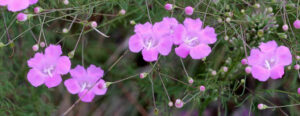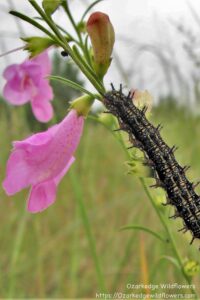 False Foxglove is named for the appearance of their brilliant pink flowers which bear a resemblance to the northern favorite Foxglove. False Foxglove actually covers a collection of closely related parasitic plants that are difficult to distinguish by all but the keenest of botanists. False Foxglove is an unusual and important Florida native plant that explodes into beautiful, vibrantly colored flowers of light purple to pink from September to December.
False Foxglove is named for the appearance of their brilliant pink flowers which bear a resemblance to the northern favorite Foxglove. False Foxglove actually covers a collection of closely related parasitic plants that are difficult to distinguish by all but the keenest of botanists. False Foxglove is an unusual and important Florida native plant that explodes into beautiful, vibrantly colored flowers of light purple to pink from September to December.

This species plays important ecological roles in Florida’s natural areas. The tubular flowers are the preferred nectar source for the larger-sized native solitary and bumble bees present in the Panhandle, although all manner of bees and butterflies will also visit. Additionally, False Foxglove is the primary host plant for the unique Common Buckeye butterfly. Common Buckeye larvae (caterpillars) feed on False Foxglove foliage during the summer before emerging as adults.
 False Foxglove is an important indicator of a healthy native ecosystem. As a parasitic plant, False Foxglove obtains nutrients and energy by photosynthesis AND by using specialized roots to tap into the roots of nearby suitable hosts (native grasses and other plants). As both False Foxglove and its parasitic host plants prefer to grow in the sunny, fire-exposed pine flatwoods and sand ridges that characterized the natural pre-settlement Florida, an area with an abundance of False Foxglove in flower is likely in good ecological shape! A perfect example of this is Torreya State Park, an area that explodes in beautiful fall foliage around September.
False Foxglove is an important indicator of a healthy native ecosystem. As a parasitic plant, False Foxglove obtains nutrients and energy by photosynthesis AND by using specialized roots to tap into the roots of nearby suitable hosts (native grasses and other plants). As both False Foxglove and its parasitic host plants prefer to grow in the sunny, fire-exposed pine flatwoods and sand ridges that characterized the natural pre-settlement Florida, an area with an abundance of False Foxglove in flower is likely in good ecological shape! A perfect example of this is Torreya State Park, an area that explodes in beautiful fall foliage around September.